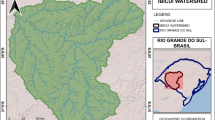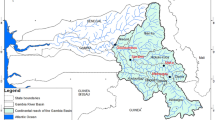Abstract
Evaluation of the applicability and utility of watershed hydrologic models in different hydro-geologic and soil conditions is necessary for a range of spatial scales and to assess the utility of these models as watershed water resources management tools. This study presents the application of the hydrological model TOPNET to the Big Darby Creek watershed, Ohio, United States. It focuses on the simulation modeling of stream flow in the watershed based on meteorological data for the eight year period of 1992–1999. Visual comparison of time series plots and statistical measures namely, Nash-Sutcliffe efficiency (NS), coefficient of correlation (R2), and the percent bias (PBIAS) were used to assess the model performance. The statistical model evaluation results indicated that the model has a relatively high confidence and can give a good representation of the flow hydrographs for the watershed. For the calibration period simulations of annual stream flow were accurate with a mean R2 and NS of 86% and 85% for the Big Darby at Darbyville gaging station. For the little Darby at West Jefferson gaging station a mean R2 of 81% was obtained while the NS averaged 78%. Further analysis based on the aggregation of the water years into wet seasons and dry seasons, the model was also able to adequately simulate stream flow for both gaging stations and for both low flow periods and high flow periods. Statistical analysis for the validation period also yielded high R2 values of 88% and 83% for the Darby at Big Darby at Darbyville gaging station and Little Darby at West Jefferson gaging station respectively. The worst PBIAS obtained for both calibration and validation period was 18% and this is better than recommended values for satisfactory daily simulations of ±25% for PBIAS. The encouraging simulation results obtained in this study shows the utility and usefulness of the TOPNET model in hydrological modeling and ultimately as a water resources management tool.
Similar content being viewed by others
References
Bandaragoda C, Tarboton D, Woods R (2004) Application of TOPNET in the distributed model intercomparison project. J Hydrol 298:178–201
Beven K (2000) Uniqueness of place and process representation in hydrological modeling. Hydrol Earth Syst Sci 4(2):203–213
Beven K, Kirkby M (1979) A physically based variable contributing area model of basin hydrology. Hydrol Sci Bull 24(1):43–69
Beven K, Lamb R, Quinn P, Romanowicz R, Freer J (1995) TOPMODEL. In: Singh VP (ed) Computer models of watershed hydrology, vol 18, chapter 18. Water Resources Publications, Highlands Ranch, CO, pp 627–668
Chaubey I, Haan C, Salisbury J, Grunwald S (1999) Quantifying model output uncertainty due to the spatial variability of rainfall. J Am Water Resour Assoc 35(5):1113–1123
Clapp R, Hornberger G (1978) Empirical equations for some soil hydraulic properties. Water Resour Res 14:601–604
Clark M, Slater A, Rupp D, Woods D, Vrugt J, Gupta H, Wagener T, Hay L (2008) A new framework for diagnosing differences between hydrological models. Water Resour Res 44:W00B02. doi:10.1029/2007WR006735
Dawdy D, Bergman J (1969) Effect of rainfall variability on stream flow simulation. Water Resour Res 5:958–966
DeVries J, Hromadka T (1993) Computer models for surface water. In: Maidment DR (eds) Handbook of hydrology. McGraw-Hill, USA, pp 21.1–21.37
Feenstra J, Short M (1996) Handbook on methods for climate change impact assessment and adaptation strategies, draft version 3. United Nations Environment Program (UNDP) and Institute for Environmental Studies, Vrije Universiteit Amsterdam, The Netherlands, pp 1-1–4-36
Gordon S, Simpson J (1994) Maintaining and improving water quality in the Big Darby Creek Watershed: agricultural and urban nonpoint water pollution. Department of City and Regional Planning, Department of Landscape Architecture, The Ohio State University, Columbus
Goring D (1994) Kinematic shocks and monoclinal waves in the Waimakariri, a steep, braided, gravel-bed river. In: Proceedings of the international symposium on waves: physical and numerical modeling, University of British Columbia, Vancouver, Canada, 21–24 August, 1994, pp 336–345
Hillel D (1998) Environmental soil physics. Academic, New York, p 757
Ibbitt R (1971) Development of a conceptual model of interception. Unpublished Hydrological Research Progress Report No. 5, Ministry of Works, New Zealand
Ibbitt R, Henderson R, Copeland J, Wratt D (2001) Simulating mountain runoff with meso-scale weather model rainfall estimates: a New Zealand experience. J Hydrol 239:19–32
Kimball J, Running S, Nemani R (1997) An improved method for estimating surface humidity from daily minimum temperature. Agric For Meteorol 85:87–98
Liu Y (1999) GIS-based spatially distributed hydrological modeling of the Barebeek catchment. MSc thesis, Vrije Universiteit Brussels, Belgium, pp 1–85
Maidment D (1992) Handbook of hydrology. McGraw Hill, New York
Maurer E, Wood A, Adam J, Lettenmaier D, Nijssen B (2002) A long-term hydrologically-based data set of land surface fluxes and states for the conterminous United States. J Climate 15:3237–3251
Nash J, Sutcliffe J (1970) River flow forecasting through conceptual models, Part 1—a discussion of principles. J Hydrol 10(3):282–290
Perrin C, Michel C, Andreassian V (2001) Does a large number of parameters enhance model performance? Comparative assessment of common catchment model structures on 429 catchments. J Hydrol 242:275–301
Rodda J (1967) The systematic errors in rainfall measurement. J Inst Water Eng 21:173–177
Rostamian R, Jaleh A, Afyuni M, Mousavi S, Heidarpour M, Jalalian A, Abbaspour K (2008) Application of a SWAT model for estimating runoff and sediment in two mountainous watersheds in central Iran. Hydrol Sci J 53(5):977–988
Singh V (1995) Computer models of watershed hydrology. Water Resources Publication, Highlands Ranch, CO
Singh V, Frevert D (eds) (2002a) Mathematical models of large watershed hydrology. Water Resources Publications, Highlands Ranch, CO
Singh V, Frevert D (eds) (2002b) Mathematical models of small watershed hydrology and applications. Water Resources Publications, Highlands Ranch, CO
Shepard D (1984) A two dimensional interpolation function for irregularly spaced data. In: Proceedings of the 23rd national conference of the American Association for Computing Machinery, New York, pp 517–523
Smith J, Seo D, Maeck M, Hudlow M (1996) An intercomparison study of NEXRAD precipitation estimates. Water Resour Res 32:2035–2045
Stellman K, Fuelberg H, Garza R, Mullusky M (2001) An examination of radar and rain gauge-derived mean areal precipitation over Georgia watersheds. Weather Forecast 16:133–144
Tarboton D (1997) A new method for the determination of flow directions and contributing areas in grid digital elevation models. Water Resour Res 33(2):309–319
Tarboton D (2002) Terrain analysis using digital elevation models (TAuDEM). Utah Water Research Laboratory, Utah State University, Logan, 84341, USA. http://www.engineering.usu.edu/dtarb
van Griensven A, Meixner T, Grunwald S, Bishop T, Diluzio M, Srinivasan R (2006) A global sensitivity analysis tool for the parameters of multi-variable catchment models. J Hydrol 324:10–23
Van L, Arnold M, Bosch D (2005) Problems and potential of auto calibrating a hydrologic model. Trans Am Soc Agric Eng 48(3):1025–1040
Willmott C, Rowe C, Philpot W (1985) Small-scale climate maps: a sensitivity analysis of some common assumptions associated with grid-point interpolation and contouring. Cartogr Geogr Inf Sci 12:5–16
Author information
Authors and Affiliations
Corresponding author
Rights and permissions
About this article
Cite this article
Guzha, A.C., Hardy, T.B. Application of the Distributed Hydrological Model, TOPNET, to the Big Darby Creek Watershed, Ohio, USA. Water Resour Manage 24, 979–1003 (2010). https://doi.org/10.1007/s11269-009-9482-6
Received:
Accepted:
Published:
Issue Date:
DOI: https://doi.org/10.1007/s11269-009-9482-6




